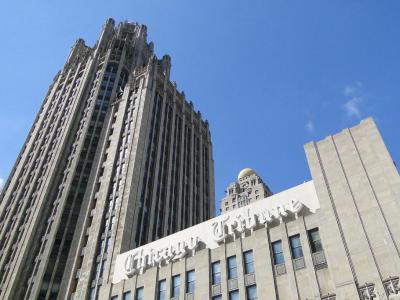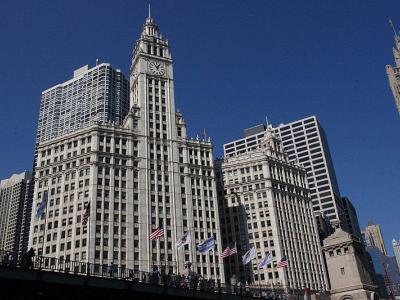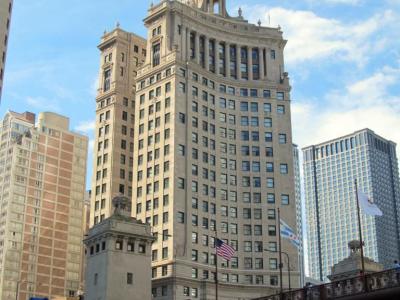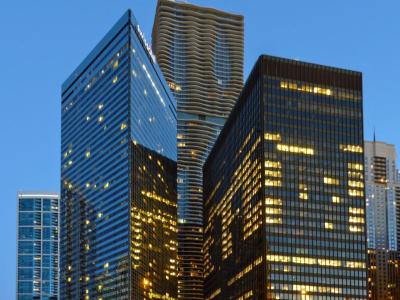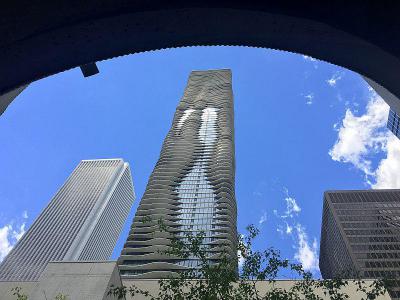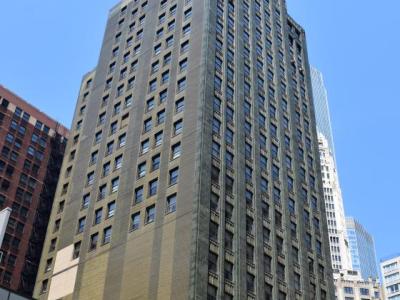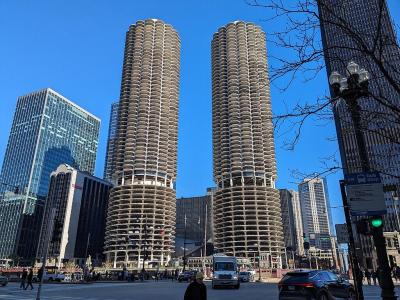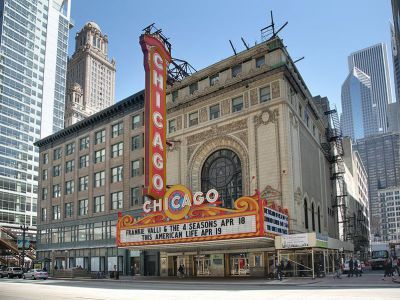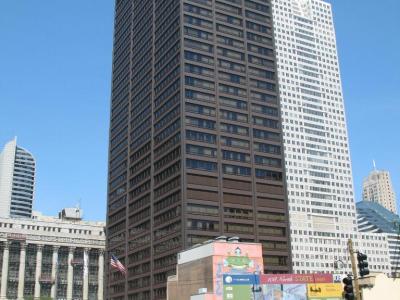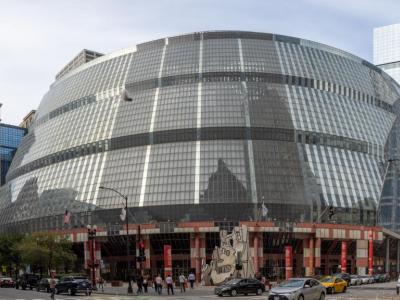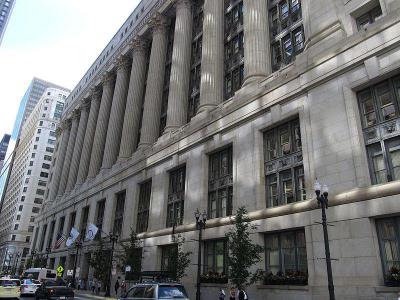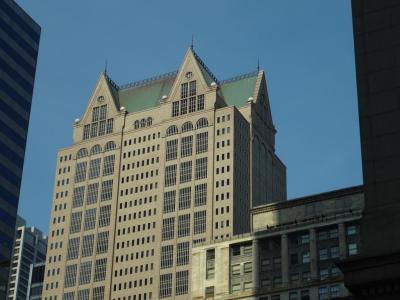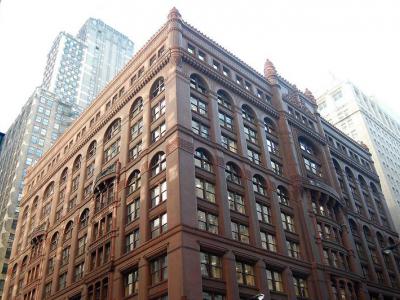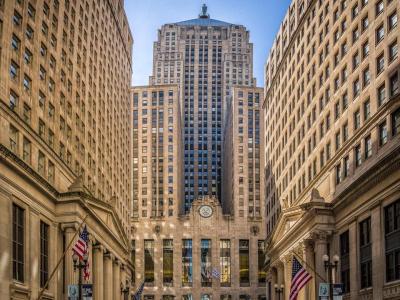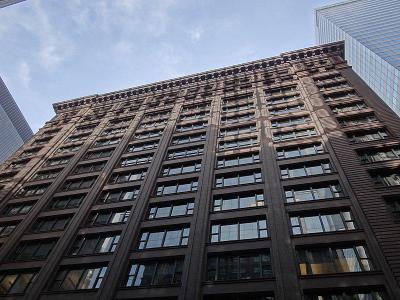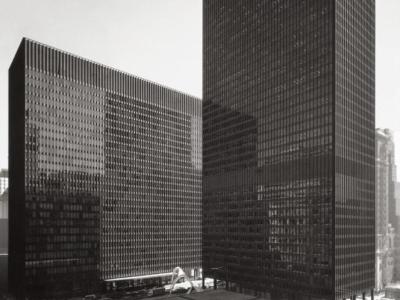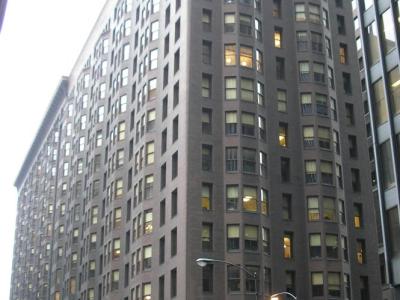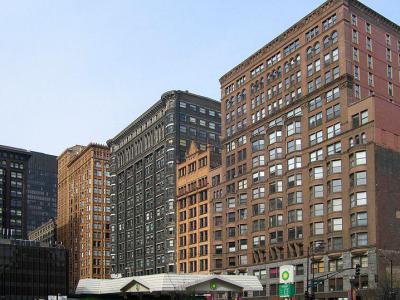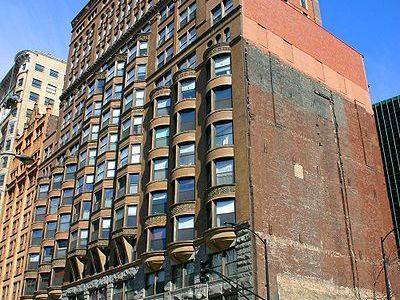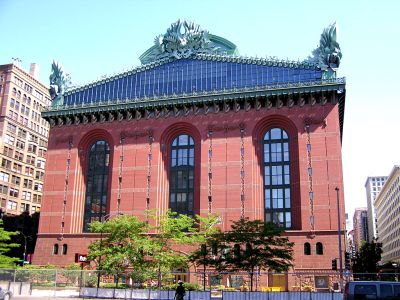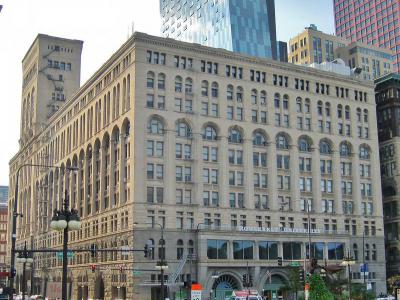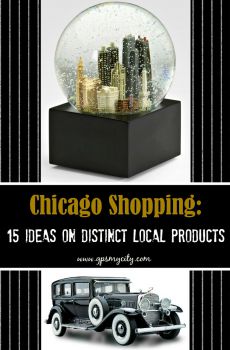Audio Guide: Loop District Architecture Walking Tour (Self Guided), Chicago
The Chicago Loop District-essentially the city’s historic downtown-has long been a stage for architectural innovation and an open-air museum of American architecture.
The construction boom started after the Great Chicago Fire of 1871, which destroyed much of the central business district, gave architects a blank canvas to rebuild the city from the ground up. What followed was a surge of creativity and experimentation that helped shape modern Chicago as we know it, from the old-school “stone and brick” into futuristic “steel and glass.”
One of the most influential styles to emerge from this period was the Chicago School, which emphasized steel-frame construction, large plate-glass windows, and minimal ornamentation-an early version of the modern skyscraper. Architects like Louis Sullivan, Dankmar Adler, and Daniel Burnham helped define this movement, focusing on function, structure, and height. Sullivan’s mantra, “form follows function,” became a guiding principle for generations of architects to come.
But the Loop doesn’t do just one style. It’s an eclectic architectural buffet, with Beaux-Arts grandeur seen in the Civic Opera House, the dark green and gold Carbide & Carbon Building screaming Art Deco glamour, the International Style clarity in Mies van der Rohe’s One Illinois Center, and bold Postmodernism in structures like the James R. Thompson Center.
The Loop is also home to some of the country’s earliest and most iconic skyscrapers, including the Rookery and the Monadnock Building, each a case study in the transition from masonry to steel construction. There's also Aqua, a rippling skyscraper with balconies looking like water waves, designed by Jeanne Gang, one of the most famous women in contemporary architecture. Also, the twin towers of Marina City-those corncob-like structures-are instantly recognizable symbols of the 1960s experimental design. Meanwhile, the bright marquee of the Chicago Theatre adds some old Hollywood sparkle to the streets.
Today, the Loop is defined by this architectural layering-historic façades rubbing shoulders with shimmering glass high-risers. Rather than one unifying style, it’s Chicago’s willingness to mix eras, materials, and philosophies that sets the district apart. If there’s anything that defines the city, it’s not a look-it’s an attitude: bold, experimental, and always looking up. However, if you ever set foot in this part of Chicago, don't just look up-walk through, explore, and feel the timeline of architecture unfold in every block of the Loop.
The construction boom started after the Great Chicago Fire of 1871, which destroyed much of the central business district, gave architects a blank canvas to rebuild the city from the ground up. What followed was a surge of creativity and experimentation that helped shape modern Chicago as we know it, from the old-school “stone and brick” into futuristic “steel and glass.”
One of the most influential styles to emerge from this period was the Chicago School, which emphasized steel-frame construction, large plate-glass windows, and minimal ornamentation-an early version of the modern skyscraper. Architects like Louis Sullivan, Dankmar Adler, and Daniel Burnham helped define this movement, focusing on function, structure, and height. Sullivan’s mantra, “form follows function,” became a guiding principle for generations of architects to come.
But the Loop doesn’t do just one style. It’s an eclectic architectural buffet, with Beaux-Arts grandeur seen in the Civic Opera House, the dark green and gold Carbide & Carbon Building screaming Art Deco glamour, the International Style clarity in Mies van der Rohe’s One Illinois Center, and bold Postmodernism in structures like the James R. Thompson Center.
The Loop is also home to some of the country’s earliest and most iconic skyscrapers, including the Rookery and the Monadnock Building, each a case study in the transition from masonry to steel construction. There's also Aqua, a rippling skyscraper with balconies looking like water waves, designed by Jeanne Gang, one of the most famous women in contemporary architecture. Also, the twin towers of Marina City-those corncob-like structures-are instantly recognizable symbols of the 1960s experimental design. Meanwhile, the bright marquee of the Chicago Theatre adds some old Hollywood sparkle to the streets.
Today, the Loop is defined by this architectural layering-historic façades rubbing shoulders with shimmering glass high-risers. Rather than one unifying style, it’s Chicago’s willingness to mix eras, materials, and philosophies that sets the district apart. If there’s anything that defines the city, it’s not a look-it’s an attitude: bold, experimental, and always looking up. However, if you ever set foot in this part of Chicago, don't just look up-walk through, explore, and feel the timeline of architecture unfold in every block of the Loop.
How it works: Download the app "GPSmyCity: Walks in 1K+ Cities" from Apple App Store or Google Play Store to your mobile phone or tablet. The app turns your mobile device into a personal tour guide and its built-in GPS navigation functions guide you from one tour stop to next. The app works offline, so no data plan is needed when traveling abroad.
Loop District Architecture Walking Tour Map
Guide Name: Loop District Architecture Walking Tour
Guide Location: USA » Chicago (See other walking tours in Chicago)
Guide Type: Self-guided Walking Tour (Sightseeing)
# of Attractions: 22
Tour Duration: 3 Hour(s)
Travel Distance: 4.7 Km or 2.9 Miles
Author: doris
Sight(s) Featured in This Guide:
Guide Location: USA » Chicago (See other walking tours in Chicago)
Guide Type: Self-guided Walking Tour (Sightseeing)
# of Attractions: 22
Tour Duration: 3 Hour(s)
Travel Distance: 4.7 Km or 2.9 Miles
Author: doris
Sight(s) Featured in This Guide:
- Tribune Tower
- Wrigley Building
- London Guarantee Building
- One Illinois Center
- Aqua (skyscraper)
- Carbide & Carbon Building
- Marina City
- Chicago Theatre
- Richard J. Daley Center
- James R. Thompson Center
- Chicago City Hall & County Building
- 190 South LaSalle
- Rookery Building
- Chicago Board of Trade Building
- Marquette Building
- Kluczynski Federal Building
- Monadnock Building
- Fisher Building
- Manhattan Building
- Harold Washington Library Center
- Fine Arts Building
- Auditorium Building
1) Tribune Tower
Not far from where the Chicago River takes a polite little turn near Michigan Avenue, stands the Tribune Tower-looking less like an office building and more like a Gothic cathedral that decided to moonlight in journalism. Complete with its flying buttresses and intricate stone scrollwork, this towering marvel was finished in 1925 to house the Chicago Tribune newspaper, thanks to the generous-and let’s say flamboyant-backing of its editor-publisher Robert "The Colonel" McCormick. Together with his charmingly disheveled partner, Joseph Patterson, the Colonel kicked off a global design contest in 1922 to mark the paper’s 75th birthday. The challenge was to create the most beautiful office building in the world. No pressure, indeed...
The winning plan came from the American duo, John Mead Howells and Raymond Hood, who rebelled against the angular, mass-produced industrial decoration monotony by embracing Britain’s Arts and Crafts movement. The result was a façade crawling with sculpted flora, fauna, and cameos from Aesop’s fables-yes, that same ancient Greek guy with the talking animals. While here, don't miss the entryway stonework, where wise owls and mischievous foxes still whisper stories to the curious.
Step into the lobby and you’re greeted by patriotic marble poetry-quotations about the freedom of the press etched into nearly every surface. And then there’s the pièce de résistance: a massive relief map of North America made of plaster and shredded U.S. dollars. Fun fact: it used to include parts of South America too… until The Colonel decided to literally cut the competition.
Though the Tribune packed up its typewriters in 2018 and the place now hosts luxury condos, the building’s grandeur hasn’t skipped a beat. The outer walls still proudly display their global passport, featuring embedded stones from architectural icons like the Parthenon, the Taj Mahal, Westminster Abbey, and even the Great Wall of China. A newspaper’s vanity project? Maybe. A stunning piece of living history? Absolutely.
The winning plan came from the American duo, John Mead Howells and Raymond Hood, who rebelled against the angular, mass-produced industrial decoration monotony by embracing Britain’s Arts and Crafts movement. The result was a façade crawling with sculpted flora, fauna, and cameos from Aesop’s fables-yes, that same ancient Greek guy with the talking animals. While here, don't miss the entryway stonework, where wise owls and mischievous foxes still whisper stories to the curious.
Step into the lobby and you’re greeted by patriotic marble poetry-quotations about the freedom of the press etched into nearly every surface. And then there’s the pièce de résistance: a massive relief map of North America made of plaster and shredded U.S. dollars. Fun fact: it used to include parts of South America too… until The Colonel decided to literally cut the competition.
Though the Tribune packed up its typewriters in 2018 and the place now hosts luxury condos, the building’s grandeur hasn’t skipped a beat. The outer walls still proudly display their global passport, featuring embedded stones from architectural icons like the Parthenon, the Taj Mahal, Westminster Abbey, and even the Great Wall of China. A newspaper’s vanity project? Maybe. A stunning piece of living history? Absolutely.
2) Wrigley Building
Just a hop, skip, and a coffee spill away from the Tribune Tower, you'll find the Wrigley Building-Chicago’s porcelain crown jewel, proudly gleaming like it just got polished for a big date. Locals love it, tourists photograph it endlessly, and the river? It just reflects it lovingly from both sides, east and west, like a doting parent.
But this beauty isn’t just showing off-it’s got history in its bones, encapsulating the essence of Chicago's architectural history up to the 1920s. Designed by the talented young architect Charles Gerhard Beersman, the structure's tripartite division draws inspiration from European traditions, a common practice among Chicago's commercial architects since the city's rebirth following the 1871 fire. Beersman was inspired by the dazzling effects of the 1893 White City designs in Chicago, leading him to embellish the building with sparkling terra-cotta cladding, using six shades of tile that start creamy at the base and ascend to a cool blue-white glow at the top. It’s like the building’s own version of a sunrise...
And at night, it doesn't go to bed either-getting lit up by a dramatic floodlight show, turning into a glowing lighthouse for downtown romantics and architecture nerds alike.
Just next door, at 401 North Wabash Avenue, is the younger, shinier neighbor: the mirrored oval Trump International Hotel & Tower. It shot up in 2008, soaring 92 stories high, briefly snagging the title of America’s second-tallest building. Originally, Donald Trump had ambitious plans to make it the world's tallest building, but these were scaled back in the aftermath of the September 11 attacks. But it still stands tall, sleek, and self-assured, curving to match the river and subtly bowing to the Wrigley Building’s elegance. Inside, it houses a luxurious hotel, opulent condos, and a fine dining establishment.
Pro tip:
Pop into the Wrigley lobby during business hours and feast your eyes on some seriously impressive brasswork. It’s like stepping into a jewelry box-only taller.
But this beauty isn’t just showing off-it’s got history in its bones, encapsulating the essence of Chicago's architectural history up to the 1920s. Designed by the talented young architect Charles Gerhard Beersman, the structure's tripartite division draws inspiration from European traditions, a common practice among Chicago's commercial architects since the city's rebirth following the 1871 fire. Beersman was inspired by the dazzling effects of the 1893 White City designs in Chicago, leading him to embellish the building with sparkling terra-cotta cladding, using six shades of tile that start creamy at the base and ascend to a cool blue-white glow at the top. It’s like the building’s own version of a sunrise...
And at night, it doesn't go to bed either-getting lit up by a dramatic floodlight show, turning into a glowing lighthouse for downtown romantics and architecture nerds alike.
Just next door, at 401 North Wabash Avenue, is the younger, shinier neighbor: the mirrored oval Trump International Hotel & Tower. It shot up in 2008, soaring 92 stories high, briefly snagging the title of America’s second-tallest building. Originally, Donald Trump had ambitious plans to make it the world's tallest building, but these were scaled back in the aftermath of the September 11 attacks. But it still stands tall, sleek, and self-assured, curving to match the river and subtly bowing to the Wrigley Building’s elegance. Inside, it houses a luxurious hotel, opulent condos, and a fine dining establishment.
Pro tip:
Pop into the Wrigley lobby during business hours and feast your eyes on some seriously impressive brasswork. It’s like stepping into a jewelry box-only taller.
3) London Guarantee Building
Say hi to the London Guarantee & Accident Building-Chicago’s take on “How fancy can an insurance office allow itself to get?” Since 1923, this Beaux-Arts beauty has been holding court on the city's skyline with all the drama and flair of a Gilded Age debutante. Designed by Alfred S. Alschuler for a British insurance firm that clearly didn’t believe in subtlety, this building is a love letter to classical architecture and Chicago’s ambition to dazzle the world, especially in the wake of the 1893 World’s Fair.
What makes it Beaux-Arts, you ask? Think Corinthian columns, Roman statues, and stonework so detailed it practically winks at you. In essence, this building is a temple to symmetry, opulence, and architectural ego. Every inch of its façade says, “Yes, we are this grand, thank you very much.”
And then there’s the crown jewel: that glorious cupola. Sitting atop the 22-story tower like a marble tiara, it features a colonnade and domed cap that scream “Look at me!” to anyone within a mile radius. It’s not just decorative-it’s competitive, throwing some elegant side-eye at the Wrigley Building across the street.
All in all, the London Guarantee Building doesn’t just occupy space-it owns it. One part classical romance, one part high-rise bravado, it’s a true Chicago original.
What makes it Beaux-Arts, you ask? Think Corinthian columns, Roman statues, and stonework so detailed it practically winks at you. In essence, this building is a temple to symmetry, opulence, and architectural ego. Every inch of its façade says, “Yes, we are this grand, thank you very much.”
And then there’s the crown jewel: that glorious cupola. Sitting atop the 22-story tower like a marble tiara, it features a colonnade and domed cap that scream “Look at me!” to anyone within a mile radius. It’s not just decorative-it’s competitive, throwing some elegant side-eye at the Wrigley Building across the street.
All in all, the London Guarantee Building doesn’t just occupy space-it owns it. One part classical romance, one part high-rise bravado, it’s a true Chicago original.
4) One Illinois Center
One Illinois Center-also known as 111 East Wacker-is what the architect Mies van der Rohe's fans might call “that gorgeous glass sermon on less-is-more.” Finished in 1967, it was the first building erected on the site of a former rail yard that once housed Fort Dearborn-swapping steam engines for steel beams in true mid-century fashion...
With this skyscraper, Mies did what he did best: taking the cold logic of the International Style and making it look effortlessly elegant. Think of it as the architectural equivalent of a perfectly tailored suit-no frills, no fuss, just razor-sharp lines and impeccable proportions. Gone was the bulky stone of old-school buildings. Instead, they got thin panes of glass wrapped in a rhythm of steel columns-orderly, restrained, and completely unapologetic about it.
There’s no grand entrance or flashy ornamentation here. That’s not the point. The building doesn’t scream for attention-it whispers class through its materials and flawless detailing. It’s industrial, yes-but make it couture.
And if you're wondering why this matters, here’s the deal: One Illinois Center marks the beginning of a new era. It set the tone for the skyscrapers that followed, showing that clean lines and structural honesty could be just as dramatic as carved angels and gilded domes.
So, whenever you stroll past 111 East Wacker, give a nod to Mies, who turned a rail yard into a minimalist masterpiece, and in the process, made glass and steel look downright poetic...
With this skyscraper, Mies did what he did best: taking the cold logic of the International Style and making it look effortlessly elegant. Think of it as the architectural equivalent of a perfectly tailored suit-no frills, no fuss, just razor-sharp lines and impeccable proportions. Gone was the bulky stone of old-school buildings. Instead, they got thin panes of glass wrapped in a rhythm of steel columns-orderly, restrained, and completely unapologetic about it.
There’s no grand entrance or flashy ornamentation here. That’s not the point. The building doesn’t scream for attention-it whispers class through its materials and flawless detailing. It’s industrial, yes-but make it couture.
And if you're wondering why this matters, here’s the deal: One Illinois Center marks the beginning of a new era. It set the tone for the skyscrapers that followed, showing that clean lines and structural honesty could be just as dramatic as carved angels and gilded domes.
So, whenever you stroll past 111 East Wacker, give a nod to Mies, who turned a rail yard into a minimalist masterpiece, and in the process, made glass and steel look downright poetic...
5) Aqua (skyscraper)
It was nearly half a century later that Marina City finally met its match with the arrival of Aqua, Jeanne Gang’s shimmering high-rise wonder. Previously, the iconic “corncobs” ruled Chicago's riverfront for decades until Aqua, standing almost 860 feet tall and dripping with design flair, stole the glances and headlines alike. It’s bold, yes-but it’s also award-winning bold, proudly holding the title of the tallest building designed by a woman-led team. Chicago, meet your new skyline showstopper!
Just like Marina City, Aqua mixes it all-homes, shops, a hotel, and offices-but while Marina rolls with the curves, Aqua plays with layers. At first glance, it’s a rectangular tower. But then Gang pulls her architectural magic trick: “vertical topography.” That’s code for balconies that ripple, wave, jut, and recede across the façade like windblown water frozen in time.
One floor might sprout a sun-catching twelve-foot terrace. The next is a minimalist ledge, just two feet deep-or nothing at all. And where the balconies vanish, Gang slides in sleek, reflective glass “pools” that mimic shimmering water tucked between the waves. On top, there's an 80,000-square-foot garden playground-designed by Ted Wolff-with actual water and greenery, just in case the metaphor wasn’t clear enough.
From afar, Aqua can disappear into the skyline, especially on grey Chicago days. But catch it in the right light, and the building pulses with movement. Try standing underneath one of its corners and look up-your brain might short-circuit trying to make sense of the constantly shifting geometry. It’s like watching the city breathe.
No two balconies here are the same. Truly brilliant in its water-like appearance, this building proves that in Chicago, architecture isn’t just built-it flows...
Just like Marina City, Aqua mixes it all-homes, shops, a hotel, and offices-but while Marina rolls with the curves, Aqua plays with layers. At first glance, it’s a rectangular tower. But then Gang pulls her architectural magic trick: “vertical topography.” That’s code for balconies that ripple, wave, jut, and recede across the façade like windblown water frozen in time.
One floor might sprout a sun-catching twelve-foot terrace. The next is a minimalist ledge, just two feet deep-or nothing at all. And where the balconies vanish, Gang slides in sleek, reflective glass “pools” that mimic shimmering water tucked between the waves. On top, there's an 80,000-square-foot garden playground-designed by Ted Wolff-with actual water and greenery, just in case the metaphor wasn’t clear enough.
From afar, Aqua can disappear into the skyline, especially on grey Chicago days. But catch it in the right light, and the building pulses with movement. Try standing underneath one of its corners and look up-your brain might short-circuit trying to make sense of the constantly shifting geometry. It’s like watching the city breathe.
No two balconies here are the same. Truly brilliant in its water-like appearance, this building proves that in Chicago, architecture isn’t just built-it flows...
6) Carbide & Carbon Building
If Fitzgerald's Gatsby ever built a skyscraper, it might have looked a lot like the Carbide & Carbon Building-Chicago’s own shimmering ode to the 1920s excess. Dreamed up by the Burnham Brothers and wrapped up just before the party ended in 1929, this Art Deco showstopper was the brainchild of the Carbide and Carbon Company-those folks who helped invent the dry cell battery. Apparently, charging things and charging forward in style went hand in hand back then...
The exterior is all black granite, green terra cotta, and actual gold leaf (yes, real 24-karat gold, although thinner than your patience in traffic), capping it all off with a glimmer that still turns heads on Michigan Avenue. It’s like the building dressed up to the nines for the Roaring Twenties and never took the outfit off...
Step inside the lobby and you’re instantly transported to a time when opulence wasn’t a dirty word. Frosted glass, Belgian marble, and a whole lot of “look at me” energy made it a showroom for the company’s latest innovations, but let’s be honest-it mostly just flexed.
Then the stock market crashed, the sequel building never got off the ground, and the jazz got a little quieter. Still, the Carbide & Carbon Building held its pose, eventually scoring landmark status in 1994 and getting a glam $106-million makeover in 2004. For a while, it rocked out as the Hard Rock Hotel, proving it could party just as hard in the 21st century as ever.
Today, it remains one of the Loop’s most bedazzled icons-a monument to ambition, design, and just a hint of gold-plated swagger.
The exterior is all black granite, green terra cotta, and actual gold leaf (yes, real 24-karat gold, although thinner than your patience in traffic), capping it all off with a glimmer that still turns heads on Michigan Avenue. It’s like the building dressed up to the nines for the Roaring Twenties and never took the outfit off...
Step inside the lobby and you’re instantly transported to a time when opulence wasn’t a dirty word. Frosted glass, Belgian marble, and a whole lot of “look at me” energy made it a showroom for the company’s latest innovations, but let’s be honest-it mostly just flexed.
Then the stock market crashed, the sequel building never got off the ground, and the jazz got a little quieter. Still, the Carbide & Carbon Building held its pose, eventually scoring landmark status in 1994 and getting a glam $106-million makeover in 2004. For a while, it rocked out as the Hard Rock Hotel, proving it could party just as hard in the 21st century as ever.
Today, it remains one of the Loop’s most bedazzled icons-a monument to ambition, design, and just a hint of gold-plated swagger.
7) Marina City
Architect Bertrand Goldberg clearly had a soft spot for curves-corners just weren’t his thing. His vision came to life in these two delightfully odd towers that locals lovingly (or sarcastically) call "the corncobs." But Goldberg insisted they were sunflowers-each curved balcony a petal unfurling toward the skyline. And just like that, he gave the stiff, boxy International Style of the 1950s a cheeky little poke in the eye.
At a time when most city folks were heading for the land of white picket fences and two-car garages, Goldberg and the Building Service Employees International Union took a bold guess: not everyone wanted suburbia. Especially not the single, the childless, or the workplace-adjacent. Turns out they were right. The complex took root, made waves, and soon became one of the most photographed architectural oddballs in the Windy City.
But Goldberg didn’t stop at funky balconies. To lure people into what was then a gritty, rail-heavy part of town, he went full visionary. Picture this: a theater, a skating rink, a bowling alley, a pool, a marina, offices, a restaurant, shops, even a health club-all under one roof, or at least in one cluster of concrete. The slogan-“A city within a city”-was a not-so-subtle jab at the suburbs, where nightlife meant folding laundry...
Built between 1964 and 1968, the towers are still going strong, filled with condos that offer jaw-dropping views and, let’s be honest, some real furniture-arrangement challenges. The first 19 floors are virtually “spiral parking garages” you either love or fear. Today, the complex is home to six restaurants, Hotel Chicago, the House of Blues, and yes, its very own marina.
Basically, these are not corncobs. They are concrete sunflowers that party in the middle of the urban jungle!
At a time when most city folks were heading for the land of white picket fences and two-car garages, Goldberg and the Building Service Employees International Union took a bold guess: not everyone wanted suburbia. Especially not the single, the childless, or the workplace-adjacent. Turns out they were right. The complex took root, made waves, and soon became one of the most photographed architectural oddballs in the Windy City.
But Goldberg didn’t stop at funky balconies. To lure people into what was then a gritty, rail-heavy part of town, he went full visionary. Picture this: a theater, a skating rink, a bowling alley, a pool, a marina, offices, a restaurant, shops, even a health club-all under one roof, or at least in one cluster of concrete. The slogan-“A city within a city”-was a not-so-subtle jab at the suburbs, where nightlife meant folding laundry...
Built between 1964 and 1968, the towers are still going strong, filled with condos that offer jaw-dropping views and, let’s be honest, some real furniture-arrangement challenges. The first 19 floors are virtually “spiral parking garages” you either love or fear. Today, the complex is home to six restaurants, Hotel Chicago, the House of Blues, and yes, its very own marina.
Basically, these are not corncobs. They are concrete sunflowers that party in the middle of the urban jungle!
8) Chicago Theatre (must see)
You can’t miss it-literally-that unmistakable marquee and the vertical towering “CHICAGO” sign blazing in red and gold above State Street! That’s the Chicago Theatre to you, showing off like it’s the city's prom queen-and honestly, with a face like that, who can blame it? Modeled after Paris’s Triumphal Arch, its façade has been photobombing tourists since 1921. Nicknamed the “Wonder Theatre of the World,” it rose from the ashes-well, sort of-right after the Great Fire, borrowing both the flair and the structural quirks of earlier architecture. Case in point: its rare cast-iron façade, one of the last survivors in the Loop, which, while stylish, has a not-so-charming tendency to melt like a grilled cheese when exposed to a blaze.
But the real scene-stealer is inside. Imagine Versailles by way of the Midwest. You’ve got grand staircases inspired by the Paris Opera House, crystal chandeliers that could outshine the sun, and a lobby that screams royal chapel chic. The 3,800-seat auditorium isn’t just massive-it’s expertly designed, so nobody gets stuck behind a pole, or worse, someone with a feathered hat...
Back in the day, the theatre dazzled audiences with silent films, live orchestras, and its mighty Wurlitzer organ-an absolute unit of an instrument. These days, it’s still flexing, hosting everything from musicals and concerts to stand-up legends. And if you're feeling nosy (or nostalgic), you can join a tour, where you will stand on the same stage graced by Sousa, Ellington, Ellen, and Queen Bey herself. Don’t skip the backstage walls either-autographs, inside jokes, and a century’s worth of showbiz spirit still echo in Sharpie ink.
So, yes, come for the photo op-but stay for the jaw-dropping grandeur, ghost stories of velvet curtains past, and maybe even a Beyoncé echo if the acoustics are just right...
But the real scene-stealer is inside. Imagine Versailles by way of the Midwest. You’ve got grand staircases inspired by the Paris Opera House, crystal chandeliers that could outshine the sun, and a lobby that screams royal chapel chic. The 3,800-seat auditorium isn’t just massive-it’s expertly designed, so nobody gets stuck behind a pole, or worse, someone with a feathered hat...
Back in the day, the theatre dazzled audiences with silent films, live orchestras, and its mighty Wurlitzer organ-an absolute unit of an instrument. These days, it’s still flexing, hosting everything from musicals and concerts to stand-up legends. And if you're feeling nosy (or nostalgic), you can join a tour, where you will stand on the same stage graced by Sousa, Ellington, Ellen, and Queen Bey herself. Don’t skip the backstage walls either-autographs, inside jokes, and a century’s worth of showbiz spirit still echo in Sharpie ink.
So, yes, come for the photo op-but stay for the jaw-dropping grandeur, ghost stories of velvet curtains past, and maybe even a Beyoncé echo if the acoustics are just right...
9) Richard J. Daley Center
Check out the Richard J. Daley Center-or as it’s sometimes called, Rust with Style. Completed in 1965, it’s a proud child of Mid-Century Modernism, wrapped in the sleek minimalism of the International Style. But forget flashy colors-this tower went with Cor-Ten steel, which is basically metal that rusts on purpose. Yes, that warm, weathered look is totally intentional. The rust forms a protective coat, so no paint, no fuss-just a whole lot of oxidized charm. Pair that with bronze-tinted windows and you’ve got yourself a building that says, “I’m tough, but I glow.”
Now, here’s where it gets clever: the Daley Center stands tall at 648 feet, but only has 31 floors. That’s because the ceilings are sky-high, with some courtrooms so tall you’d half expect them to echo. And the support system is pure engineering poetry. Just 16 steel columns hold this beast up-12 along the edges and four snug around the elevators. The rest of the space is wide open, thanks to some beefy Warren trusses doing the heavy lifting behind the scenes.
Architect Jacques Brownson wasn’t merely thinking big-he was thinking up. Those columns actually get slimmer the higher they go, which isn’t just a flex in aesthetics-it reflects the decreasing weight they carry. Indeed, it’s tall-standing architecture that’s making a point while doing it.
So, being downtown and observing that rust-hued giant with the Picasso sculpture out front, remember-it’s not decaying. It’s aging gracefully, like a brutalist sommelier in a steel suit...
Now, here’s where it gets clever: the Daley Center stands tall at 648 feet, but only has 31 floors. That’s because the ceilings are sky-high, with some courtrooms so tall you’d half expect them to echo. And the support system is pure engineering poetry. Just 16 steel columns hold this beast up-12 along the edges and four snug around the elevators. The rest of the space is wide open, thanks to some beefy Warren trusses doing the heavy lifting behind the scenes.
Architect Jacques Brownson wasn’t merely thinking big-he was thinking up. Those columns actually get slimmer the higher they go, which isn’t just a flex in aesthetics-it reflects the decreasing weight they carry. Indeed, it’s tall-standing architecture that’s making a point while doing it.
So, being downtown and observing that rust-hued giant with the Picasso sculpture out front, remember-it’s not decaying. It’s aging gracefully, like a brutalist sommelier in a steel suit...
10) James R. Thompson Center
The James R. Thompson Center-Chicago’s boldest architectural flex and probably the only government building that looks like it was dreamed up during a sugar rush. Designed by Helmut Jahn and opened in 1985, this glassy, candy-colored spaceship crash-landed in the Loop to declare: “Bureaucracy can be funky too.”
Meant to symbolize transparency and accessibility (both metaphorically and quite literally-hello, all-glass walls), the Thompson Center gathered 50 state agency offices under one postmodern roof, tossed in a food court, and called it a civic center. It’s part government building, part community hangout, and part architectural fever dream.
Being here, you can't help talking curves-because this place loves them. The southeast side sweeps upward in blue glass and salmon-pink steel, evoking the grand domes of historic government buildings while breaking away from the strict linearity of modernism. The dome-like shape pays homage to the Illinois State Capitol in Springfield, adding a historical reference to its otherwise contemporary appearance. Meanwhile, the facades overlooking LaSalle and Lake Street keep things a bit more traditional-grid lines, symmetry, restraint-so that the neighbors don’t panic.
Inside, it’s a whole other planet. The 13-story rotunda is a jaw-dropper: 160 feet wide, skylit, and circled by open balconies like an office colosseum. Glass elevators zoom up and down, escalators crisscross, and down below, the food court buzzes with everything from lunch-break chitchat to existential dread about the Department of Motor Vehicles line. The rotunda serves as a vibrant heart of the complex, enhancing its role as a “people’s center.”
Now, cooling this giant glass building is no small task. The solution?-is ice slush (seriously). The building makes ice at night when energy’s cheap, stores it in basement tanks, then uses it to chill the place by day. Efficient and refreshing-like a Slurpee for the Heating, Ventilating, and Air Conditioning system.
Indeed, the Thompson Center is equally weird, wild, and wonderfully open-and it just might be the only government building that could double as a sci-fi movie set...
Meant to symbolize transparency and accessibility (both metaphorically and quite literally-hello, all-glass walls), the Thompson Center gathered 50 state agency offices under one postmodern roof, tossed in a food court, and called it a civic center. It’s part government building, part community hangout, and part architectural fever dream.
Being here, you can't help talking curves-because this place loves them. The southeast side sweeps upward in blue glass and salmon-pink steel, evoking the grand domes of historic government buildings while breaking away from the strict linearity of modernism. The dome-like shape pays homage to the Illinois State Capitol in Springfield, adding a historical reference to its otherwise contemporary appearance. Meanwhile, the facades overlooking LaSalle and Lake Street keep things a bit more traditional-grid lines, symmetry, restraint-so that the neighbors don’t panic.
Inside, it’s a whole other planet. The 13-story rotunda is a jaw-dropper: 160 feet wide, skylit, and circled by open balconies like an office colosseum. Glass elevators zoom up and down, escalators crisscross, and down below, the food court buzzes with everything from lunch-break chitchat to existential dread about the Department of Motor Vehicles line. The rotunda serves as a vibrant heart of the complex, enhancing its role as a “people’s center.”
Now, cooling this giant glass building is no small task. The solution?-is ice slush (seriously). The building makes ice at night when energy’s cheap, stores it in basement tanks, then uses it to chill the place by day. Efficient and refreshing-like a Slurpee for the Heating, Ventilating, and Air Conditioning system.
Indeed, the Thompson Center is equally weird, wild, and wonderfully open-and it just might be the only government building that could double as a sci-fi movie set...
11) Chicago City Hall & County Building
This edifice may look like your average government headquarters, but it’s really two office buildings in a trench coat-designed around light wells and doing double duty as City Council headquarters, thanks to a two-story interruption in the office floors.
The idea behind it was to build an eleven-story structure that wouldn't scream “skyscraper!” The solution was achieved by doubling the size of the exterior façade, reducing the number of windows, and introducing the biggest columns Chicago had ever seen-seventy-five feet tall, hollow, and made from fifteen massive granite slices. The Corinthian capitals on top are so tall, they’re basically equal to an extra floor. And to hold all that decorative drama in place, ten-foot-wide underground caissons were used. Yep, it’s as much sculpture as it is structure.
Wrapped in Classical Revival style, the whole thing was officially unveiled in 1911. Step up to the Chicago City Hall entrance and you’ll see four granite relief panels, each representing one of the city government’s Big Four concerns: playgrounds, schools, parks, and water supply. Head inside and you’re greeted by elegant marble staircases and bronze plaques honoring the many city halls Chicago has cycled through since 1837 (with this current one being the fanciest).
In 2006, the City Hall’s roof got a green makeover (literally). A full-blown garden was planted up top as part of a study on green roofs-tracking everything from heat island effects and stormwater runoff to which plants could hack it in Chicago’s mood-swinging weather. Bonus: it gave scientists the chance to compare energy use with the old-school roof on the County side next door.
So, yes, it's official: bureaucracy has never looked this architecturally ambitious-or environmentally curious.
The idea behind it was to build an eleven-story structure that wouldn't scream “skyscraper!” The solution was achieved by doubling the size of the exterior façade, reducing the number of windows, and introducing the biggest columns Chicago had ever seen-seventy-five feet tall, hollow, and made from fifteen massive granite slices. The Corinthian capitals on top are so tall, they’re basically equal to an extra floor. And to hold all that decorative drama in place, ten-foot-wide underground caissons were used. Yep, it’s as much sculpture as it is structure.
Wrapped in Classical Revival style, the whole thing was officially unveiled in 1911. Step up to the Chicago City Hall entrance and you’ll see four granite relief panels, each representing one of the city government’s Big Four concerns: playgrounds, schools, parks, and water supply. Head inside and you’re greeted by elegant marble staircases and bronze plaques honoring the many city halls Chicago has cycled through since 1837 (with this current one being the fanciest).
In 2006, the City Hall’s roof got a green makeover (literally). A full-blown garden was planted up top as part of a study on green roofs-tracking everything from heat island effects and stormwater runoff to which plants could hack it in Chicago’s mood-swinging weather. Bonus: it gave scientists the chance to compare energy use with the old-school roof on the County side next door.
So, yes, it's official: bureaucracy has never looked this architecturally ambitious-or environmentally curious.
12) 190 South LaSalle
Strolling down LaSalle Street in Chicago’s financial district for the first time, you might just miss 190 South LaSalle. Its base plays it cool, all calm masonry and buttoned-up elegance, blending in like a banker at a board meeting. But look up, and boom-there’s that unmistakable green gabled roof, crashing the skyline party like it forgot it was supposed to be “understated.”
Designed by the dynamic duo of Philip Johnson and John Burgee, this skyscraper is pure Postmodern swagger. This style, emerging in the 1980s and 90s, represents a departure from the restrained International Style championed by Mies van der Rohe. Gone are the clean, no-nonsense lines, as if to say, “Why be minimal when you can be memorable?” And 190 South LaSalle gets the memo loud and clear, with grand gestures, oversized flourishes, and a rooftop that practically winks at you through the clouds.
What makes it fun is the contrast: from the sidewalk, it’s all composed and corporate; from afar, it’s theatrical and proud. It borrows from tradition but isn’t afraid to turn up the volume, making it a playful love letter to Chicago’s architectural past, dressed in the 1980s attitude.
So, exploring this part of the Loop, don’t forget to look up-because 190 South LaSalle is proof that even the most modest facades can hide a flair for the dramatic.
Designed by the dynamic duo of Philip Johnson and John Burgee, this skyscraper is pure Postmodern swagger. This style, emerging in the 1980s and 90s, represents a departure from the restrained International Style championed by Mies van der Rohe. Gone are the clean, no-nonsense lines, as if to say, “Why be minimal when you can be memorable?” And 190 South LaSalle gets the memo loud and clear, with grand gestures, oversized flourishes, and a rooftop that practically winks at you through the clouds.
What makes it fun is the contrast: from the sidewalk, it’s all composed and corporate; from afar, it’s theatrical and proud. It borrows from tradition but isn’t afraid to turn up the volume, making it a playful love letter to Chicago’s architectural past, dressed in the 1980s attitude.
So, exploring this part of the Loop, don’t forget to look up-because 190 South LaSalle is proof that even the most modest facades can hide a flair for the dramatic.
13) Rookery Building
Ah, the Rookery Building-Chicago’s architectural mic drop. Built in 1888 by Daniel Burnham and John Wellborn Root, it is where old-school charm meets cutting-edge-for-its-time innovation. Think of it as the stylish grandparent of modern office buildings-Romanesque bones, steel nerves, and a serious obsession with natural light.
Now, about that name. After the Great Fire of 1871, the city set up a temporary city hall on this very spot, right next to a water tank that, apparently, was the hottest hangout for local crows. People dubbed it “The Rookery,” a cheeky nod to both the birds and the shady politicians nesting inside. Classic Chicago...
When Burnham and Root came in, they kept the name and turned the site into an 11-story marvel. Root even carved a pair of rooks into the stone entrance, just in case you missed the reference. Inside is an architectural mixtape: fireproofing, elevators, electric lights, and a glass-roofed central light court that would make your inner plant absolutely thrive.
In 1905, Frank Lloyd Wright entered the chat. Hired to revamp the interior, he ditched Root’s ironwork and went full diva with white Carrara marble, gold-leafed arabesques, and a vibe that screams “gilded age glow-up.” The double staircase spirals like a mechanical dream, and the second-floor balcony feels like you’re walking through the inside of a very elegant watch.
Outside, it’s all brick, marble, and terra cotta-layered like an architectural tiramisu, blending Romanesque, Queen Anne, Roman Revival, and even some Art Deco from a 1931 facelift.
Want in? The Frank Lloyd Wright Trust offers tours Monday through Friday, and Inside Chicago keeps the doors open daily for curious walkers and film buffs-yes, The Untouchables and Home Alone 2 were all filmed here.
So, feel free to look up, look in, and maybe bring a rook call-just for the old time’s sake...
Now, about that name. After the Great Fire of 1871, the city set up a temporary city hall on this very spot, right next to a water tank that, apparently, was the hottest hangout for local crows. People dubbed it “The Rookery,” a cheeky nod to both the birds and the shady politicians nesting inside. Classic Chicago...
When Burnham and Root came in, they kept the name and turned the site into an 11-story marvel. Root even carved a pair of rooks into the stone entrance, just in case you missed the reference. Inside is an architectural mixtape: fireproofing, elevators, electric lights, and a glass-roofed central light court that would make your inner plant absolutely thrive.
In 1905, Frank Lloyd Wright entered the chat. Hired to revamp the interior, he ditched Root’s ironwork and went full diva with white Carrara marble, gold-leafed arabesques, and a vibe that screams “gilded age glow-up.” The double staircase spirals like a mechanical dream, and the second-floor balcony feels like you’re walking through the inside of a very elegant watch.
Outside, it’s all brick, marble, and terra cotta-layered like an architectural tiramisu, blending Romanesque, Queen Anne, Roman Revival, and even some Art Deco from a 1931 facelift.
Want in? The Frank Lloyd Wright Trust offers tours Monday through Friday, and Inside Chicago keeps the doors open daily for curious walkers and film buffs-yes, The Untouchables and Home Alone 2 were all filmed here.
So, feel free to look up, look in, and maybe bring a rook call-just for the old time’s sake...
14) Chicago Board of Trade Building
Standing tall like a stone sentinel at the heart of Chicago’s financial district, the Chicago Board of Trade Building doesn’t whisper authority but shouts it in bold syllables. This 45-story tower, conceived during the height of the Art Deco era by architects John A. Holabird and John Wellborn Root Jr., made its grand entrance in 1930, right when ziggurats and geometric glam were all the rage.
Clad in gray Indiana limestone and shadowy recesses, the facade shoots upward with the confidence of a stockbroker on a winning streak. It’s all about vertical drama-lean, clean, and mean. Art Deco lovers, get ready: the crisp lines, stylized ornamentation, and throne-like silhouette make this building less of an office block and more of a sculpted sermon in stone.
But wait-look up. Capping it all off like a literal cherry on top is a pyramidal crown, stoically guarded by a faceless aluminum goddess: Ceres, the Roman deity of agriculture. Sculpted by John Storrs, she’s got no face-because who needs one when you’ve got that kind of industrial-era mystique? Her smooth gown and robotic vibe scream 1930s modernism, wrapped in a toga.
In short, this building is a temple to commerce, a monument to style, and a prime example of how Chicago doesn't just build high-it builds with swagger.
Clad in gray Indiana limestone and shadowy recesses, the facade shoots upward with the confidence of a stockbroker on a winning streak. It’s all about vertical drama-lean, clean, and mean. Art Deco lovers, get ready: the crisp lines, stylized ornamentation, and throne-like silhouette make this building less of an office block and more of a sculpted sermon in stone.
But wait-look up. Capping it all off like a literal cherry on top is a pyramidal crown, stoically guarded by a faceless aluminum goddess: Ceres, the Roman deity of agriculture. Sculpted by John Storrs, she’s got no face-because who needs one when you’ve got that kind of industrial-era mystique? Her smooth gown and robotic vibe scream 1930s modernism, wrapped in a toga.
In short, this building is a temple to commerce, a monument to style, and a prime example of how Chicago doesn't just build high-it builds with swagger.
15) Marquette Building
Imagine slipping a sleek, tailored cover over an iron skeleton-that’s the Marquette Building, constructed in 1895. Underneath its crisp, geometric skin hides a tough steel frame, one of the early hallmarks of Chicago’s vertical ambitions. The base is rugged stone. The crown is an ornate cornice that looks like it belongs on a royal pastry. But most of the façade sticks to business: form follows function, with clean lines that echo the structure’s bones. Inside, every office hugs the building’s arms, ensuring that each room gets a slice of sunlight, either from the street or the central light well. Think efficiency with a touch of elegance...
The building takes its name from Jacques Marquette, the Jesuit priest and explorer whose 1674–75 journal gave Europe its first written peek at what we now call Chicago. Owen F. Aldis-part real estate developer, part amateur historian, full-on fanboy-translated the journal in 1891 and made it the heart and soul of the building. That’s why you’ll spot reliefs on the exterior showing scenes from Marquette’s adventures, as if the building’s wearing a historic graphic novel on its face.
Inside the lobby, you may feel like you’re in a jewel box: bronze fixtures gleam under a Tiffany glass mosaic that narrates Marquette’s journey with serious flair. Over the elevators are bronze reliefs of French explorers and Native Americans mid-expedition. And if you wander just a bit farther, you’ll find a mini-exhibit on the building’s history and recent restoration-brought to you by the MacArthur Foundation, which, fittingly, is one of the tenants here.
All of this came from the minds of Holabird & Roche, two architects who started out as draftsmen for the guy who basically invented skyscrapers, William Le Baron Jenney. Indeed, these guys didn’t just raise buildings-they raised the bar...
The building takes its name from Jacques Marquette, the Jesuit priest and explorer whose 1674–75 journal gave Europe its first written peek at what we now call Chicago. Owen F. Aldis-part real estate developer, part amateur historian, full-on fanboy-translated the journal in 1891 and made it the heart and soul of the building. That’s why you’ll spot reliefs on the exterior showing scenes from Marquette’s adventures, as if the building’s wearing a historic graphic novel on its face.
Inside the lobby, you may feel like you’re in a jewel box: bronze fixtures gleam under a Tiffany glass mosaic that narrates Marquette’s journey with serious flair. Over the elevators are bronze reliefs of French explorers and Native Americans mid-expedition. And if you wander just a bit farther, you’ll find a mini-exhibit on the building’s history and recent restoration-brought to you by the MacArthur Foundation, which, fittingly, is one of the tenants here.
All of this came from the minds of Holabird & Roche, two architects who started out as draftsmen for the guy who basically invented skyscrapers, William Le Baron Jenney. Indeed, these guys didn’t just raise buildings-they raised the bar...
16) Kluczynski Federal Building
The Kluczynski Federal Building, part of the Chicago Federal Center, was designed by Ludwig Mies van der Rohe and is a prime example of the architect’s philosophy of "Less is more." Indeed, he meant it...
Finished in 1974, this sleek steel-and-glass tower epitomizes Mies' commitment to simplicity, modernity, and efficiency. The design marked a significant shift in public architecture, aligning with Mies' vision of creating functional, streamlined structures. The construction was part of a broader urban renewal initiative led by Mayor Richard J. Daley, aimed at revitalizing downtown Chicago and reinvigorating its struggling economy.
Now, Mies wasn’t just designing buildings-he was laying down a philosophy. Everything here obeys the grid: columns, lights, benches, even the pavement. It’s all perfectly aligned like a well-organized inbox. “God is in the details,” Mies liked to say, and this complex proves he wasn’t kidding. Every line has its purpose, every angle behaves.
But don’t let the minimalist look fool you-this place isn’t cold or lifeless. The plaza out front is a full-blown social stage. One day it’s a farmers market, the next a political rally, maybe even a dance performance if you hang around long enough. It’s government architecture that doesn’t just house bureaucracy-it invites people in, boots off, opinions welcome...
Critic Franz Schulze once called it a “monumental urban presence,” and honestly, that hits the nail on the head. It’s calm, cool, and seriously confident-a visual mic drop right in the heart of Chicago.
Whenever passing by the Federal Center, take a minute. Stand still. Breathe it in. Precision can be powerful-and here, even the silence is symmetrical.
Finished in 1974, this sleek steel-and-glass tower epitomizes Mies' commitment to simplicity, modernity, and efficiency. The design marked a significant shift in public architecture, aligning with Mies' vision of creating functional, streamlined structures. The construction was part of a broader urban renewal initiative led by Mayor Richard J. Daley, aimed at revitalizing downtown Chicago and reinvigorating its struggling economy.
Now, Mies wasn’t just designing buildings-he was laying down a philosophy. Everything here obeys the grid: columns, lights, benches, even the pavement. It’s all perfectly aligned like a well-organized inbox. “God is in the details,” Mies liked to say, and this complex proves he wasn’t kidding. Every line has its purpose, every angle behaves.
But don’t let the minimalist look fool you-this place isn’t cold or lifeless. The plaza out front is a full-blown social stage. One day it’s a farmers market, the next a political rally, maybe even a dance performance if you hang around long enough. It’s government architecture that doesn’t just house bureaucracy-it invites people in, boots off, opinions welcome...
Critic Franz Schulze once called it a “monumental urban presence,” and honestly, that hits the nail on the head. It’s calm, cool, and seriously confident-a visual mic drop right in the heart of Chicago.
Whenever passing by the Federal Center, take a minute. Stand still. Breathe it in. Precision can be powerful-and here, even the silence is symmetrical.
17) Monadnock Building
If buildings could talk, the Monadnock would probably argue with itself. Why? Because this Chicago landmark is literally two buildings in one-a tale of architectural evolution told in brick, steel, and just a bit of stubbornness.
The northern half, finished in 1891 by Burnham & Root, is all about muscle and minimalism. Here, thick brick walls-six feet at the corners-do the heavy lifting like the architectural equivalent of a bodybuilder in a turtleneck. It’s bold, it’s stripped-down, and those curvy bay windows supported by sneaky cantilevered steel quietly hint at the modern era to come. There’s something ancient about it, too-its battered base and massive lines recall Egyptian temples, if pharaohs had high-rises...
Now pivot south, and the building gets a little more refined. Completed in 1893 by Holabird & Roche, this section looks as if saying, “Why carry weight with bricks when steel can do the job?” Here, the brick and terra cotta are just decorative icing on a rigid metal frame cake. It’s sleeker, smarter, and structurally way ahead of its time. Think of it as the moment architecture traded in its overalls for a tailored suit.
Together, these two halves tell a story of transition-from traditional load-bearing walls to steel skeletons, from masonry might to modern grace. In essence, this building is a brick-and-mortar argument about the future.
Come to think of it, strolling by the Monadnock, you may as well give it a wink, for you’re not just looking at architecture-you’re eavesdropping on a 19th-century design debate still standing tall in the 21st.
The northern half, finished in 1891 by Burnham & Root, is all about muscle and minimalism. Here, thick brick walls-six feet at the corners-do the heavy lifting like the architectural equivalent of a bodybuilder in a turtleneck. It’s bold, it’s stripped-down, and those curvy bay windows supported by sneaky cantilevered steel quietly hint at the modern era to come. There’s something ancient about it, too-its battered base and massive lines recall Egyptian temples, if pharaohs had high-rises...
Now pivot south, and the building gets a little more refined. Completed in 1893 by Holabird & Roche, this section looks as if saying, “Why carry weight with bricks when steel can do the job?” Here, the brick and terra cotta are just decorative icing on a rigid metal frame cake. It’s sleeker, smarter, and structurally way ahead of its time. Think of it as the moment architecture traded in its overalls for a tailored suit.
Together, these two halves tell a story of transition-from traditional load-bearing walls to steel skeletons, from masonry might to modern grace. In essence, this building is a brick-and-mortar argument about the future.
Come to think of it, strolling by the Monadnock, you may as well give it a wink, for you’re not just looking at architecture-you’re eavesdropping on a 19th-century design debate still standing tall in the 21st.
18) Fisher Building
Standing 275 feet tall with the attitude of a sea monster in Sunday best, the Fisher Building has loomed over Chicago’s Loop since 1896. Back then, it was one of just two 18-story titans in the city-the other being the now-vanished Masonic Building. The Fisher, on the other hand, has refused to go quietly. It’s still the oldest surviving 18-story structure in town, proudly holding its steel frame like a seasoned actor refusing to exit the stage.
Back in 1998, instead of a wrecking ball, the Fisher got a facelift. Sold and converted from a tired office space into stylish rental apartments, the building went full glow-up. Its ornate façade-crawling with eagles, dragons, and sea creatures (a tribute to its nautical-loving developer, Lucius G. Fisher)-was painstakingly restored. And we’re not talking some minor touch-ups, no-over 6,000 terra-cotta pieces were remade and replaced, like rebuilding a ceramic jigsaw puzzle with mythical flair.
The main entrances on Dearborn and Plymouth, previously lost to time (and bad decisions), were brought back to life. Meanwhile, 1,200 wood-frame windows-classic examples of the Chicago School style-were either carefully restored or swapped out. Inside, you’ll find mosaic floors and Carrara marble walls whispering tales of 19th-century ambition, all wrapped up in a lobby that gracefully mixes the old with the tastefully new.
In short, the Fisher didn’t just survive-it evolved. From office block to apartment icon, it’s a living fossil with a great paint job.
Back in 1998, instead of a wrecking ball, the Fisher got a facelift. Sold and converted from a tired office space into stylish rental apartments, the building went full glow-up. Its ornate façade-crawling with eagles, dragons, and sea creatures (a tribute to its nautical-loving developer, Lucius G. Fisher)-was painstakingly restored. And we’re not talking some minor touch-ups, no-over 6,000 terra-cotta pieces were remade and replaced, like rebuilding a ceramic jigsaw puzzle with mythical flair.
The main entrances on Dearborn and Plymouth, previously lost to time (and bad decisions), were brought back to life. Meanwhile, 1,200 wood-frame windows-classic examples of the Chicago School style-were either carefully restored or swapped out. Inside, you’ll find mosaic floors and Carrara marble walls whispering tales of 19th-century ambition, all wrapped up in a lobby that gracefully mixes the old with the tastefully new.
In short, the Fisher didn’t just survive-it evolved. From office block to apartment icon, it’s a living fossil with a great paint job.
19) Manhattan Building
After the Great Chicago Fire of 1871 turned downtown into a giant bonfire of hopes and timber, a curious thing happened: architects flocked to the smoldering ruins like bees to a blueprint. Why? Well, it was a designer’s dream-no pesky rules, endless demand, and a wide-open playing field. As the ashes were still warm, a certain William Le Baron Jenney stepped up, rolled up his sleeves, and quietly began inventing the future.
Now, Jenney wasn’t just some guy with a drawing board-he was the grand architect-dad of the Chicago School. His genius move was ditching the massive stone walls and using an internal steel skeleton to hold up the building instead. It was revolutionary, it was bold... and sadly, his 1885 Home Insurance Building-the so-called first skyscraper-no longer graces the skyline. But despair not, architectural fans! His Manhattan Building of 1891 still stands tall and proud, like an elderly titan flexing its bones of steel.
Back in the day, people called it “Hercules” when they saw it at the 1893 World’s Fair-and not without reason. This beauty was the first tall building to go full skeleton-mode, the first U.S. structure to hit sixteen stories, and even enjoyed a brief moment as the tallest building on Earth. It also introduced fancy new wind bracing-because even Hercules needs help standing up in Chicago’s famous gusts. The bay windows-smart move. Granite on the bottom, brick on top-even smarter. Cantilevered bays, so the neighboring buildings didn’t crumble-the smartest.
In short, the Manhattan Building wasn’t just ahead of its time-it practically invented it.
Now, Jenney wasn’t just some guy with a drawing board-he was the grand architect-dad of the Chicago School. His genius move was ditching the massive stone walls and using an internal steel skeleton to hold up the building instead. It was revolutionary, it was bold... and sadly, his 1885 Home Insurance Building-the so-called first skyscraper-no longer graces the skyline. But despair not, architectural fans! His Manhattan Building of 1891 still stands tall and proud, like an elderly titan flexing its bones of steel.
Back in the day, people called it “Hercules” when they saw it at the 1893 World’s Fair-and not without reason. This beauty was the first tall building to go full skeleton-mode, the first U.S. structure to hit sixteen stories, and even enjoyed a brief moment as the tallest building on Earth. It also introduced fancy new wind bracing-because even Hercules needs help standing up in Chicago’s famous gusts. The bay windows-smart move. Granite on the bottom, brick on top-even smarter. Cantilevered bays, so the neighboring buildings didn’t crumble-the smartest.
In short, the Manhattan Building wasn’t just ahead of its time-it practically invented it.
20) Harold Washington Library Center
Opened in 1991 and named after Chicago’s first African American mayor, the Harold Washington Library Center emerged as the winning project of a high-profile design competition in 1988. Out of all the flashy contenders, this one went full traditionalist-with a twist. Architect Thomas Beeby cooked up a Neoclassical-inspired concoction that tips its hat to the past but avoids slavish adherence to all its stuffy architectural rules.
From the outside, the building is granite, brick, and just the right amount of whimsical, assuming the role of a uniquely postmodern tribute to Chicago's architectural heritage. The robust and textured ground level pays homage to the Rookery Building, while the stepped-back, upper windows echo the grand arched balconies in the Auditorium Theatre. The swirling terra-cotta ornamentation takes inspiration from the Marquette Building, and the glass curtain wall on the west side is a nod to sleek 1950s modernism. Oh, and let’s not forget the cherry on top: massive metal owls perched on the roof, ready to offer either sage advice or perhaps just some hoots of wisdom with passive-aggressive stares.
But here’s the kicker-the real “wow” moment isn’t at the front door. It’s nine floors up. Ride the elevator to the Winter Garden, a sun-drenched atrium that feels more like a peaceful plaza than the top of a library. Right below, the 8th floor accommodates practice rooms for musicians and serves as a venue for listening to rare recordings or playing the piano. The second floor’s old library space (now known as the Cultural Center) is equally captivating, featuring the world's largest Tiffany dome within its splendid chamber. The kids’ library is a sprawling 18,000-square-foot wonderland complete with the wall-mounted figures by Chicago Imagist Karl Wirsum, while the walkway above the main lobby displays works by renowned Chicago artists. Ultimately, every floor here has surprises-poetry, exhibits, and enough character to fill several novels.
And yes, it’s officially in the Guinness Book as the world’s largest public library.
Pro tip:
Head straight to the 9th floor. Trust us. Glass ceilings never looked so liberating.
From the outside, the building is granite, brick, and just the right amount of whimsical, assuming the role of a uniquely postmodern tribute to Chicago's architectural heritage. The robust and textured ground level pays homage to the Rookery Building, while the stepped-back, upper windows echo the grand arched balconies in the Auditorium Theatre. The swirling terra-cotta ornamentation takes inspiration from the Marquette Building, and the glass curtain wall on the west side is a nod to sleek 1950s modernism. Oh, and let’s not forget the cherry on top: massive metal owls perched on the roof, ready to offer either sage advice or perhaps just some hoots of wisdom with passive-aggressive stares.
But here’s the kicker-the real “wow” moment isn’t at the front door. It’s nine floors up. Ride the elevator to the Winter Garden, a sun-drenched atrium that feels more like a peaceful plaza than the top of a library. Right below, the 8th floor accommodates practice rooms for musicians and serves as a venue for listening to rare recordings or playing the piano. The second floor’s old library space (now known as the Cultural Center) is equally captivating, featuring the world's largest Tiffany dome within its splendid chamber. The kids’ library is a sprawling 18,000-square-foot wonderland complete with the wall-mounted figures by Chicago Imagist Karl Wirsum, while the walkway above the main lobby displays works by renowned Chicago artists. Ultimately, every floor here has surprises-poetry, exhibits, and enough character to fill several novels.
And yes, it’s officially in the Guinness Book as the world’s largest public library.
Pro tip:
Head straight to the 9th floor. Trust us. Glass ceilings never looked so liberating.
21) Fine Arts Building
Built around 1884, this stone-clad beauty kicked off the architectural groove along South Michigan Avenue. Picture a chunky Romanesque base, elegant arches perched on beefy red granite columns, and voilà-instant showroom glam for Studebaker carriages on the first five floors. These arches didn’t just look good-they functioned like giant picture windows for horsepower on wheels. And up top-a shift in tempo: smaller, clustered windows marking the spaces where carriages and wagons were once assembled, piece by clunky piece...
Years later, Studebaker exited the stage, and in waltzed Charles C. Curtiss-a music publisher with a taste for reinvention. He commissioned architect Beman to turn the place into a one-stop creative playground. Out went the wheels, in came the arts. The building grew up-literally-gaining three new skylit floors to house studios and artistic ambition. Eventually, this revamped gem even hosted suffragettes and, by the 1920s, found itself at the heart of Chicago’s literary whirl.
Step inside today, and you're in for a maze of wood-paneled hallways humming with history. There’s the whimsical Venetian Court, a vertical slice of charm complete with internal balconies, plus original Art Nouveau murals that refuse to be ignored. The building now houses ten floors of artistic energy-painters, pianists, dancers, and dreamers all under one roof. Pop by the FAB Second Floor Art Gallery or listen for the gentle piano echoes from PianoForte down below.
There may be no curtain calls or dance classes for visitors, but art is everywhere here, if you know where to look. So, given the opportunity, don't hesitate to take a stroll through the courtyard, let the soaring sopranos and brooding baritones serenade you, and enjoy the sweet chaos of artists doing what they do best-creating magic in broad daylight.
Years later, Studebaker exited the stage, and in waltzed Charles C. Curtiss-a music publisher with a taste for reinvention. He commissioned architect Beman to turn the place into a one-stop creative playground. Out went the wheels, in came the arts. The building grew up-literally-gaining three new skylit floors to house studios and artistic ambition. Eventually, this revamped gem even hosted suffragettes and, by the 1920s, found itself at the heart of Chicago’s literary whirl.
Step inside today, and you're in for a maze of wood-paneled hallways humming with history. There’s the whimsical Venetian Court, a vertical slice of charm complete with internal balconies, plus original Art Nouveau murals that refuse to be ignored. The building now houses ten floors of artistic energy-painters, pianists, dancers, and dreamers all under one roof. Pop by the FAB Second Floor Art Gallery or listen for the gentle piano echoes from PianoForte down below.
There may be no curtain calls or dance classes for visitors, but art is everywhere here, if you know where to look. So, given the opportunity, don't hesitate to take a stroll through the courtyard, let the soaring sopranos and brooding baritones serenade you, and enjoy the sweet chaos of artists doing what they do best-creating magic in broad daylight.
22) Auditorium Building
If buildings could take a bow, Chicago’s Auditorium Building would still be taking curtain calls. A crown jewel of the Chicago School architectural style, it’s most famous for its jaw-dropping, 4,000-seat theatre-so acoustically perfect and visually flawless that the legendary Modernist maestro Frank Lloyd Wright, never one for casual compliments, called it “the greatest room for music and opera in the world.”
Constructed in 1889 by the architectural dream team of Louis Sullivan and Dankmar Adler, the building launched them into the architectural stratosphere. Adler brought the theatre savvy, Sullivan brought the flair, and together they built a masterpiece that would make modernist hearts flutter for decades.
The plan was to create a home for Chicago’s cultural elite-opera, symphony, high society, and all that jazz-while sneaking in a 400-room hotel, office space, and retail to pay the bills. Grand idea! Sadly, within ten years, the glam had faded, and the building went from high notes straight into disrepair, with its lowest point marked by a transformation into a recreational center for soldiers who ingeniously repurposed the stage as a makeshift bowling alley.
Luckily, in 1946, Roosevelt University stepped in to rescue the ailing beauty. By the 1960s, restoration efforts hit their stride, and in 1989, the theater celebrated its 100th anniversary with a musical bang-Les Misérables show. Then came a 2001 revamp, complete with forensic paint matching, delicate stencil work, and a lovingly revived mural. In 2002, the original stage (bless its battered soul) was replaced just in time for the sold-out run by the Bolshoi Ballet, which garnered critical acclaim.
So, even if your schedule is tighter than a soprano’s corset, try and squeeze in a tour of this historic gem-you’ll walk through history, acoustics, and just a little architectural drama.
Constructed in 1889 by the architectural dream team of Louis Sullivan and Dankmar Adler, the building launched them into the architectural stratosphere. Adler brought the theatre savvy, Sullivan brought the flair, and together they built a masterpiece that would make modernist hearts flutter for decades.
The plan was to create a home for Chicago’s cultural elite-opera, symphony, high society, and all that jazz-while sneaking in a 400-room hotel, office space, and retail to pay the bills. Grand idea! Sadly, within ten years, the glam had faded, and the building went from high notes straight into disrepair, with its lowest point marked by a transformation into a recreational center for soldiers who ingeniously repurposed the stage as a makeshift bowling alley.
Luckily, in 1946, Roosevelt University stepped in to rescue the ailing beauty. By the 1960s, restoration efforts hit their stride, and in 1989, the theater celebrated its 100th anniversary with a musical bang-Les Misérables show. Then came a 2001 revamp, complete with forensic paint matching, delicate stencil work, and a lovingly revived mural. In 2002, the original stage (bless its battered soul) was replaced just in time for the sold-out run by the Bolshoi Ballet, which garnered critical acclaim.
So, even if your schedule is tighter than a soprano’s corset, try and squeeze in a tour of this historic gem-you’ll walk through history, acoustics, and just a little architectural drama.
Walking Tours in Chicago, Illinois
Create Your Own Walk in Chicago
Creating your own self-guided walk in Chicago is easy and fun. Choose the city attractions that you want to see and a walk route map will be created just for you. You can even set your hotel as the start point of the walk.
Millennium and Grant Parks Walking Tour
If Chicago had a living room, it would be Grant Park - and if it had a shiny new media room, that would definitely be Millennium Park. These two sprawling green spaces hug the lakeshore like the city’s favorite blanket, offering locals and tourists alike a perfect blend of nature, art, and architecture with a side of skyline.
Let’s start with the elder of the two - Grant Park, established... view more
Tour Duration: 2 Hour(s)
Travel Distance: 2.7 Km or 1.7 Miles
Let’s start with the elder of the two - Grant Park, established... view more
Tour Duration: 2 Hour(s)
Travel Distance: 2.7 Km or 1.7 Miles
Chicago Chinatown Walking Tour
Tucked away just south of the Loop, the Chinatown of Chicago was established in 1912 and is considered one of the best examples of American Chinatown. While it may be one of Chicago’s smallest neighborhoods geographically, it is big on character, colors, sights, sounds, and flavors. Here, you’ll find a wide range of unique boutiques, specialty shops, religious sights, authentic Chinese... view more
Tour Duration: 1 Hour(s)
Travel Distance: 1.7 Km or 1.1 Miles
Tour Duration: 1 Hour(s)
Travel Distance: 1.7 Km or 1.1 Miles
Chicago Introduction Walking Tour
Chicago, perched on the shores of Lake Michigan in Illinois, is a city steeped in history and urban vibrancy. Known by numerous nicknames such as the Windy City and the City of Big Shoulders, it boasts a skyline marked by towering structures. The area of today's Chicago, initially inhabited by Native American tribes, saw its first European-settled reference as "Chicagou" in 1679, a... view more
Tour Duration: 2 Hour(s)
Travel Distance: 3.9 Km or 2.4 Miles
Tour Duration: 2 Hour(s)
Travel Distance: 3.9 Km or 2.4 Miles
Chicago Navy Pier Walking Tour
Additional to scenic views of the lake, the boats, and the city skyline, the Navy Pier offers a variety of attractions on the waterfront – for kids as well as adults – that draw nearly ten million people annually, making this Chicago's most visited spot. Yes, some may see it as a “tourist trap”, but it is worth the time and money to spend some time here, so take this self-guided walk... view more
Tour Duration: 1 Hour(s)
Travel Distance: 1.0 Km or 0.6 Miles
Tour Duration: 1 Hour(s)
Travel Distance: 1.0 Km or 0.6 Miles
University of Chicago Walking Tour
Founded in 1890, the University of Chicago is among the world’s most prestigious educational institutions. As of 2020, the University’s students, faculty and staff have included 100 Nobel laureates, giving it the fourth-most affiliated Nobel laureates of any university.
Set in the heart of Chicago’s famous eclectic neighborhood, Hyde Park, the campus is worth a visit as it offers a... view more
Tour Duration: 2 Hour(s)
Travel Distance: 2.5 Km or 1.6 Miles
Set in the heart of Chicago’s famous eclectic neighborhood, Hyde Park, the campus is worth a visit as it offers a... view more
Tour Duration: 2 Hour(s)
Travel Distance: 2.5 Km or 1.6 Miles
Chicago Old Town Walking Tour
Settled in 1850 by German immigrants, Chicago’s Old Town neighborhood is a popular destination for locals and visitors who cater to the entertainment venues, restaurants, pubs, coffee shops and boutiques – all of which have turned an area once referred to as the “Cabbage Patch” into an attraction that rivals Navy Pier, Wrigley Field and the Magnificent Mile.
Start your Old Town walking... view more
Tour Duration: 2 Hour(s)
Travel Distance: 2.6 Km or 1.6 Miles
Start your Old Town walking... view more
Tour Duration: 2 Hour(s)
Travel Distance: 2.6 Km or 1.6 Miles
Useful Travel Guides for Planning Your Trip
Chicago Souvenirs: 15 Distinct Local Products to Bring Home
One of the most fascinating cities in the U.S., if not the whole world, Chicago has no shortage of things closely associated with it, often due to their direct origin (blues, gangstership, etc.), so one might literally be spoiled for choice as to what to choose as a "piece" of Chicago to...
The Most Popular Cities
/ view all



